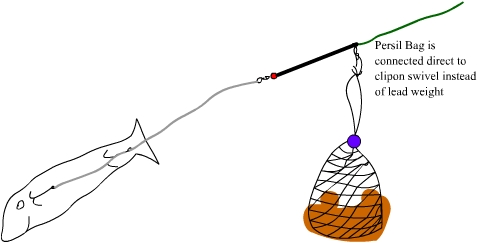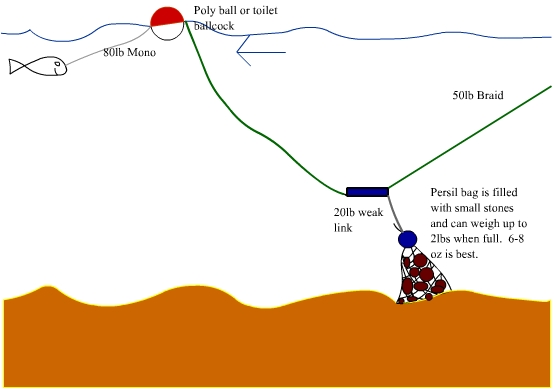
Home
Articles
News
Find Us
Rules
Join Us
Gallery
The Persil Tablet Bag
Ian Wakeford

Ever found something that you can't resist using even though it looks a bit daft. Well since those little detergent tablet bags were introduced a few years ago, I now always keep a stock it my rucksack, they are as invaluable as rubber bands. Now that's saying something.
Firstly for Piking I have been using them as rubby dubby bags, I get old deadbaits and chop them up into small pieces. If you fill one of these Persil bags up with bits of fish, then it will create an oil slick to flatten the waves during a force eight gale. There are two ways of attaching the bag to your rig; I will try and explain the approaches I have used.
Firstly, if you are fishing close in or do not need range, then you could completely do away with a lead weight. Just attach the loop of the bag to a clip on swivel instead of a lead. Assuming the fish is thawed out it will sink slowly, resting on any weed.

Alternatively, for venues that require a little more distance or have a modest flow, then you will be better to attach a lead as usual, then enclose the lead within the bag, pulling the drawstring tight. This will require quite a strong rod to cast but also has the added benefit the draw string is not firmly fitted to the lead, in a snag it would slip and release the lead.

I have not tried them for attracting eels, but I am sure that they would work, the only worry is that they will probably try and eat the bag. They are also great at catching crayfish, they get tangled up a treat in the netting!!!
The other use that I have been impressed with is that of an adjustable weight that you can risk loosing. The biggest problem I have found is on fishing large baits for Catfish on rivers such as the Ebro in Spain. The river is so snaggy that your bottom lead could be lost every cast, and 6-8oz leads are not cheap, even in Spain. What I have been fishing quite successfully last year is a winch rig set-up, where you at first cast out the bag of stones, keeping the trace swivel wrapped around your foot, or attaching some lighter line to it, casting the whole rig out and winding the trace swivel back.
Either way you end up with a bag of stones about 20 yards out, with the trace swivel on dry land. You then attach the livebait and slowly retrieve line until the bait is wound out completely to the bag of stones. In reality there will be an angle of about 45 degrees between the stones and bait. In strong currents and snaggy bottoms what tends to happen is that the whole rig tends to slowly creep down river. This would happen with a lead weight as well, until the rig meets a snag, the rig then holds fast.
When a catfish takes the bait it will probably hook itself against the 20lb weak link and then proceed to snap it. Leaving you with a free running rig line all the way to the fish. I can confirm this approach works, catching my personal best by this method. It makes a change to the bottle rig anyway and means that it can be fished on your own without the need for a boat. However range is limited to the distance you can throw the stones or cast them. So not all swims are suitable.

Lastly, still working on the above principle, these bags are great when filled with gravel as ballast. I have fished swims where I have been unable to get tent pegs into the ground, so a dozen of so of these bags filled with gravel is great for staking out your bivvy round the edges. And at the end of the day, you empty them out. No heavy weights to carry. Ever tried taking 20lb of lead on a plane? I have, they want to know why you coat pockets are full of this stuff. Very hard to explain and very tiring to carry about when your baggage allowance is already used up with other tackle and a change of underpants.
(C) Baintonfisheries.co.uk, 29 May, 2014 . All rights reserved, no reproduction without prior permission
For Comments or Suggestions please E-Mail.
